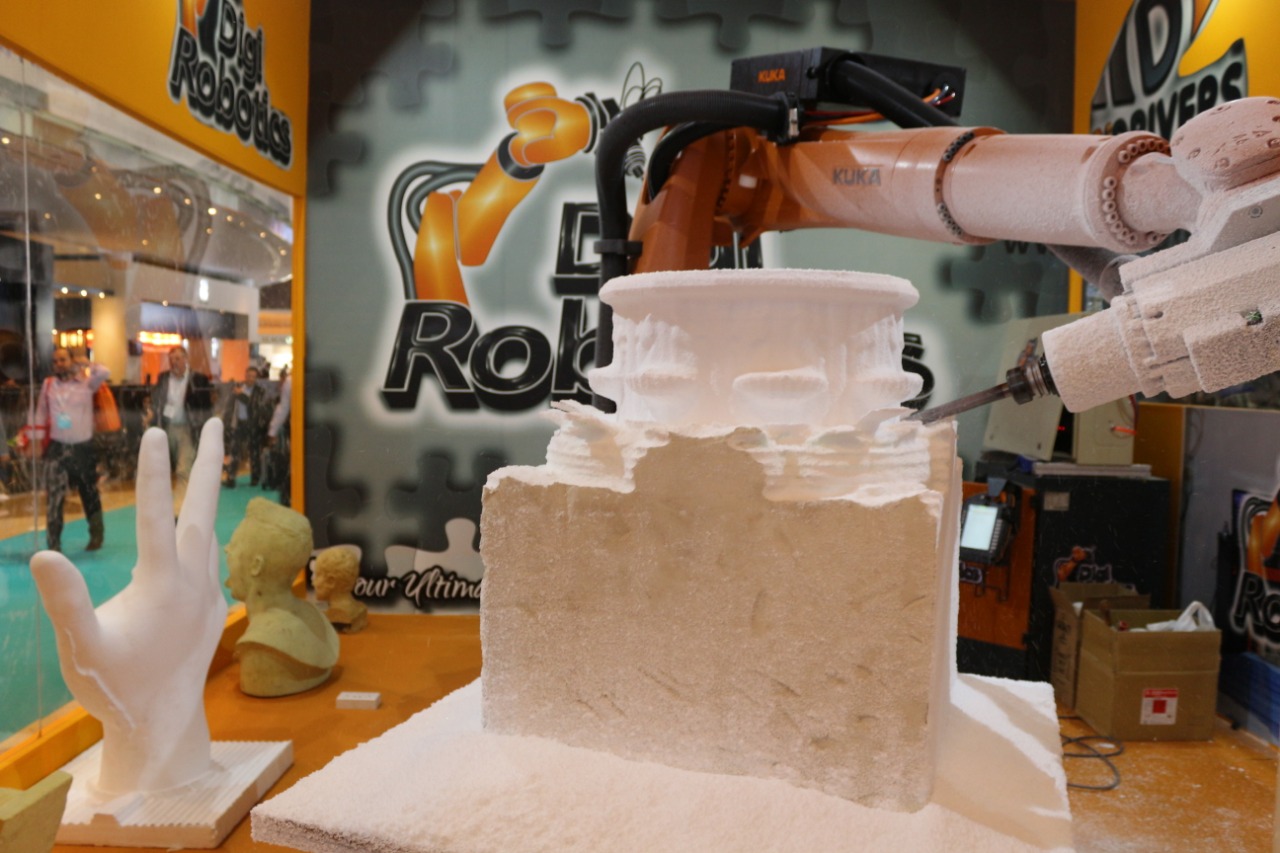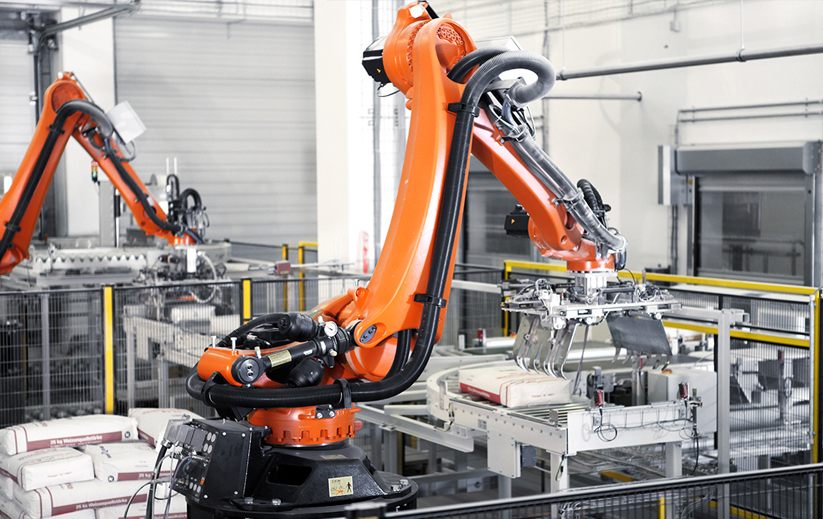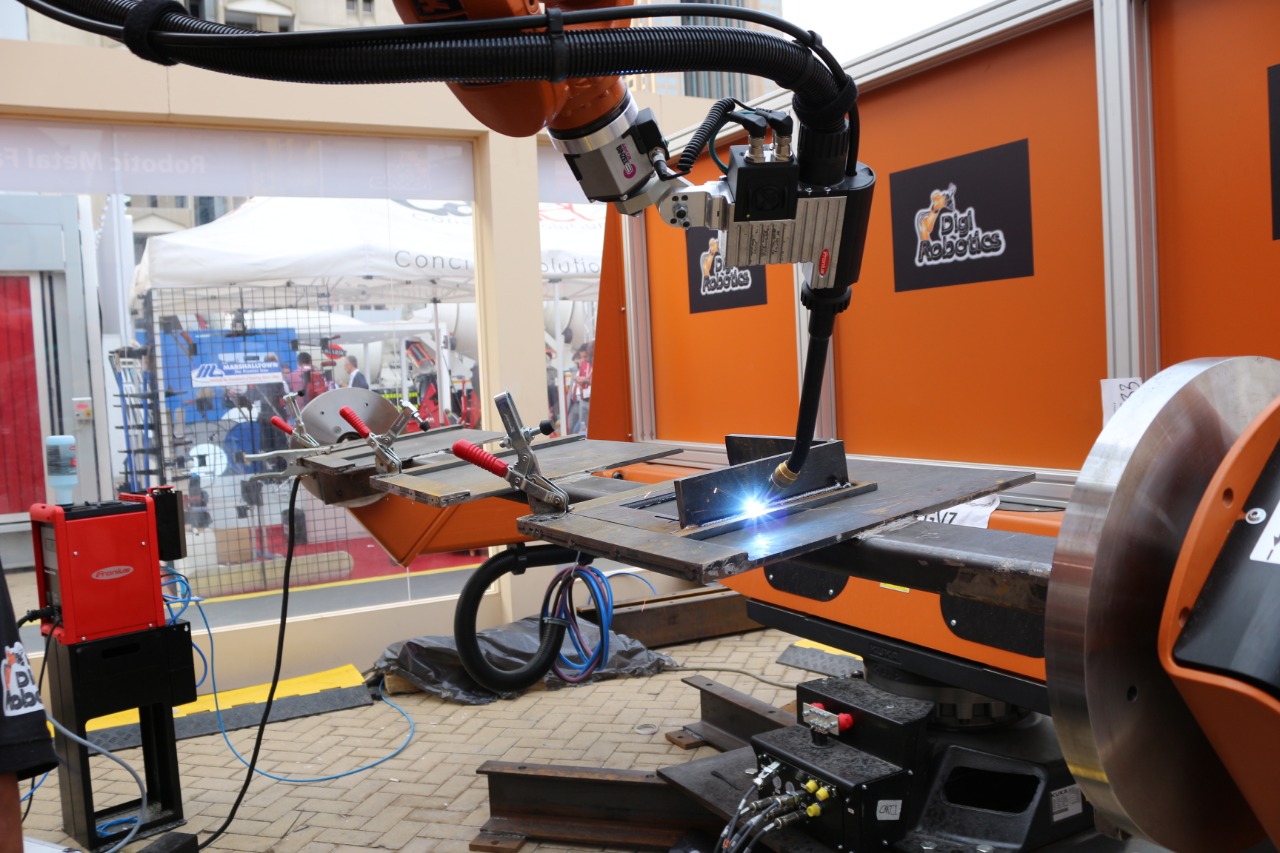Take Your Production to Higher Productivity and Efficiency

DG World is a leading company in the Middle East, providing state-of-the-art Automation Robotics solutions for Manufacturing processes, ordering, testing, handling the materials, 3D Printing, etc.As the result, we are able to guide our clients in the direction of industry 4.0 with future-oriented solutions.We are the official system Partner of KUKA in the Middle East and AfricaWith a combination of KUKA’s World class quality and DGWorld’ s creativity & utmost commitment to customers, we are pioneering innovation in Robotics.In fact, this has been the basis for decades of exception technology, helping you to decisive process optimization.
Our passion is finding future-oriented solutions to make even complex automation tasks simple. Whatever you want to do and no matter the specific tasks involved: you can implement it with DGWorld. And thanks to close cooperation with our partner (KUKA) that applies to every industry.
We strive to turn your ideas into reality. Use our edge to drive your success.
DGWorld offers the complete Turnkey Solutions from Engineering to Project Management, from Assembly and Test to After Sales Service and we offer you Customized Automation Solutions from Industrial Robots to Complete Production Lines and optimize existing systems.
About KUKA Industrial Robots
KUKA is the world's leading provider of production systems in the automotive industry. We in DGWorld, consider Automation and Industrial KUKA Robotic applications as the core of our Business, KUKA is our Premium Partner based on the Mutual agreement between us and under the official System Partnership collaboration.
We have vast variety of industrial robotic system solution and we will find a solution for you, no matter how challenging the applications:


Automation:
The requirements for manufacturers are increasing, which need more flexible production processes. The solution is in automating production.
our target is to support the manufacturing factories in the holistic optimization of the production process by providing comprehensive automation and digitization know-how.
Industry 4.0:
intelligence beyond automation by intelligently and securely connecting all manufacturing machines to the cloud, we increase your production efficiency and process quality in a sustainable manner. Smart Production enables all to consistently digitize whole production lines. It creates an interoperable network, in which microservices and Big Data analyses can be used to analyze and lastingly improve manufacturing efficiency, quality, and flexibility.
We offer our customers the full range of products and services from a single source from the core component – the robot – to manufacturing cells, turnkey systems and networked production with the aid of cloud-based IT tools.
In order to make new working environments both highly productive and ergonomically beneficial for the labor force, we are implementing with our partners central key technologies such as collaborative robots, mobile assistance systems, autonomously controlled vehicles and intelligently networked automation solutions that support humans in the work setting, easing the workload in a variety of ways.




Human Robot Collaborative:
In human-robot collaboration, the robot assists the human operator. This means: The machine does not replace the human, but complements his capabilities and relieves him of arduous tasks
Human-robot collaboration is revolutionizing industrial production and manufacturing in the factory of the future and bringing decisive advantages
Mobile industrial robotics:
Manufacturing processes are changing constantly. This is why mobile robot systems must be very adaptable. Maximum mobility and autonomous working methods optimize your production significantly. The omnidirectional drive can move in any direction from a standing start, achieving full freedom of movement in 360 degrees and combining robotics system Arms for more flexibility in flow of work process and this technology is based on the Mecanum wheel and gives your vehicle unlimited maneuverability.
The omnidirectional wheel technology allows the vehicle to move in any direction. The wheel consists of two rims and nine free-running rollers, which are mounted at a 45-degree angle.


OmniMove
is a transport platform for heavy loads. Move it with great ease into the right position – with ultra-precision and in the tightest of spaces and it is also offers excellent mobility, easily operated by remote control with Simply move underneath and lift: the OmniMove mobile heavy-duty platform can move your XXL loads with ease
The OmniMove can be controlled manually or move autonomously. Despite its enormous size and payload capacity, it navigates safely, moving virtually independently. You can also optionally expand it with a self-contained energy supply.
Features of Omnimove :
KMR QUANTEC
is the mobile industrial robot system and It moves the robot to the exact location needed – whether for the construction of ships, aircraft or wind turbines. Even very large components can be processed easily and it is consisting of the omniMove platform and robot of the KR QUANTEC series as well as software and a controller
Autonomous KMR iiwa robot
is an ideal basis for the intelligent, networked production worlds of Industrie 4.0 with HRC-capable and mobile and It combines the strengths of the sensitive LBR iiwa lightweight robot with those of a mobile, autonomous platform .
it is a special focus on fleet management Two or more autonomous stations can work simultaneously, piloted by a single server through Wi-Fi connection
Features of the system:
Many applications can be done with KMR iiwa and These range from fetch-and-carry services to roles in producing small quantities at multiple workstations, all the way through to complex, flexible production workflows in the automotive and electronics industries.
Research and develops technologies: Robotics systems and automation are among the most exciting and most future-oriented areas of research.
Foodstuffs
Aerospace
Stone
Entertainment
Hospitality
Electronics
Logistics
Chemicals
Nuclearize Energy
Oil and Gas
Cosmetics
Pharmaceuticals
Airports /Air planes
Metal and Fabrication
Wood Processing
DGWorld Cutting Robotics Systems
Robot cutting systems perform material removal applications that could be tedious or injury-inducing for human workers, improving the safety standard and quality. the robot is designed for a high level of precision performance, creating a high-quality product for the manufacturer.
Safe cutting with Robotics
Safety is a key to any manufacturing industry. When safety is not a priority in a shop, there are more instances of downtime and production interruptions, due to sickness and injuries. When you use a robot for your cutting application, these types of interruptions can be almost completely eradicated, which improves your safety level, while also improving the level of morale in your factory
Read more

Any time you cut a piece of material, tiny particles surrounding the edges of the material will be released in the air. If you’re talking about food particles or biodegradable particles, that may not be a big deal. But, in metal plate cutting. When metal is cut, very small shards can be released into the air. If a human worker was performing the cutting application close to the work piece, those shards could be breathed into their respiratory system and cause buildup and disease over time
Another issue that may be a problem using cutting applications without the use of robots like the laser cutter, is the issue of workers burning or cutting their hands during the instance of manual application. When choosing a KUKA robotic laser cutter, manufacturers are getting a system that keeps workers back away from the danger zone during operation, which keeps their body away from the heat and possible particles produced during the application process. When downtime is decreased and workers are no longer ill, morale is raised in the shop overall, which is always a good thing.
See more about our Cutting Solutions.
High productivity with Accuracy:
Cutting technologies
The specific requirements of each component determine which cutting process is the most appropriate. Give us a call and together we will find the technology best suited to your production needs.
The Advantage for Cutting by robotics system:


DGWorld Milling Robotics Systems
Milling is classified as a machining process. Metals, wood Stone, Tiles, Granite, Gypsum Board, GRC and plastics can be machined with a milling tool. A milling robot can make this production process even more flexible.
Milling: the technology
Milling shapes the workpiece as desired by removing superfluous material chips by means of a geometrically defined cutting edge and rotation of the cutting tool.
Would you like a machine to handle the milling? No problem. Our milling robots can carry out the machining tasks just like machine tools – as a matter of fact, they are even more flexible and versatile.
Read moreHigh-precision robotic milling
High-precision robotic milling is a core competence of DGWORLD: we process components with High accuracy. We focus primarily on:
See more about our Milling Solution.
Milling: the advantages
Our experience and engineering ensure a high degree of flexibility through our milling robots and variable combinations of robots and machine tools. As DGWORLD customer, you can choose between various system solutions:
DGWorld Robotics Palletizing system
Automated palletizing refers to an industrial robot palletizer performing the application automatically.
Palletizing robots can be seen in many industries including food processing, manufacturing, logistics, and shipping.
There is a large variety of robotic palletizers available with a large range of payload and arm reach.
Various end-of-arm-tooling styles allow flexibility of different types of robot palletization. Bag grippers encompass an item and support it on the bottom, while suction and magnetic grippers typically handle more ridged items and grip them from the top. By automating your shop with a palletizing robot, you can increase the consistency of loading and unloading processes.
Read more

DGWorld help companies design the perfect palletizing system for their facility and application by incorporating a new or used palletizer.
The palletizing and depalletizing applications come with payloads from 40 to 1,300 kilograms and reaches of up to 3,601 millimeters.
With compact palletizing robots in the medium payload category, you are ideally equipped for the rapid stacking.
The palletizing robot energy-efficient high-speed stackers in the high payload category, perfect for palletizing tasks in confined spaces. For very heavy payloads, our heavy-duty palletizers can lift loads weighing more than a tone.
See more about our Palletizing Solution.
Ergonomics:
“Ergonomics” – people hear that word thrown around the workplace all the time. So, what exactly is “ergonomics”? Ergonomics is an applied science that centers on equipment design that intends to maximize productivity by reducing operator fatigue and discomfort.
When human workers perform palletizing functions manually, they are forcing their bodies to lift, bend, and twist several times per hour. This can cause severe back, neck and leg injuries over time. These injuries drive up labor costs for the manufacturer and are dangerous to the employee.
These injuries can also decrease productivity as workers get slower due to aches and pains, or when a new person has to train in an area due to a worker who is out of work due to injury.
This situation can cause a huge problem with the ergonomics for manual palletizing. No matter how scientists slice it, humans have their limits, and over time, their bodies will break down due to strained, repetitive tasks.
Enter the palletizing robot. This machine does not need breaks. It does not take sick leave or vacation. It does not even need a couple of days off here and there. It could, in theory, run 24 hours a day, seven days a week, 365 days a year.
The robot is stronger and faster than a human – even a human using a lift assist. Some robot palletizers Can lift 1350kg at a time with an increased accuracy and repeatability over manual applications.
The improved productivity and cycle times are a plus for manufacturers. These robotic palletizing systems not only decrease the cycle times for production lines, they save on labor and production costs while increasing the manufacturers’ return on investment.
Switching to automated robotic palletizing may be the only ergonomic solution for palletizing in the workplace. It keeps workers away from heavy lifting and trains them on how to run the robot. This gives workers a new set of skills and saves them from painful and dangerous back-breaking labor, which ultimately creates a win-win situation for manufacturer and employee.
Palletizing system technologies and combines:
DGWORLD have several palletizing solutions from the robots, grippers technologies, sensors, software, and conveyers’ systems that can cover several different palletizing needs. There are robots that can be mounted from the floor, wall, shelf or ceiling, lending to diverse layouts and workspace availability.
If you in the market to switch to automated palletizing to decrease labor costs, increase productivity, and protect your employees, contact us and our engineers will work with you to find the right robot palletizing system to fit your facility’s needs.
In Order Fulfillment, there a few robotic solutions that are really revolutionizing the material handling world. These include Layer Forming and Inline Palletizing, Layer Depalletizing and Palletizing, and Mixed Case Palletizing, each have specific benefits that can truly improve a client’s operations with marked productivity, flexibility, and reliability.
Types of Robotic Palletizing Solutions:
You can palletize different sized load units on the same pallet using gripping systems that can stack packages from above into available gaps.
Fork gripper
Whether handling bagged goods or cardboard boxes: the fork gripper ensures reliable, gentle and precise stacking of both product types. It can handle up to 600 units per hour.
Double fork gripper
The powerful double fork gripper stacks bagged goods and cardboard boxes with a capacity of up to 900 units per hour; this is also possible by moving two units per travel path.
Finger gripper
The finger gripper is a high capacity tool for stable bags. It can palletize up to 1,200 bags per hour.
Double finger gripper
The double finger gripper is used if large quantities of stable bags need to be palletized. It can position up to 1,900 bags per hour for the palletizing process.
Pallet gripping device
The installation of a pallet gripping device allows for feeding the empty pallets without an additional empty pallet conveyor.
Suction gripper
The suction gripper is recommended for bundles with sanctionable surfaces: it can stack up to 400 bundles per hour while gently handling the product. Even unstable packaged goods can be palletized reliably.
Parallel gripper
The parallel gripper performs especially well when palletizing stable bundles with parallel side walls, i.e. cardboard boxes: it can stack up to 600 cardboard boxes per hour.
Special gripper
For individual requirements, special gripping systems are developed and dimensioned for the specific products and performance characteristics.
Palletizing robots: Your advantages
Robot Palletizing vs Conventional Palletizing
Palletizing equipment comes in many shapes and sizes. While there are many different palletizing equipment layouts, manufacturers really have to evaluate their processes to see if robotic palletizing will be more beneficial for your facility than manual palletizing.
Some important things to consider are:
Conventional palletizers can create a pattern when loading, but robots can make user-friendly loads. Robot palletizers can also handle difficult loads and high speeds of production.
Robot palletizers are great solutions for applications where the product demands precision. Bags and pails are perfect examples of this. The need to precisely place items like pails on pallets is necessary, for example, because pails need to be placed on top of each other in a very specific way, “nesting” on the lid of the pail below it.
Robot palletizers also have the ability to work in confined spaces or environments full of dust and other particles, which make them great for bag palletizing applications.
Since conventional palletizers never have to pick up a product, as opposed to just moving a product, they can handle several different types of products with little to no problem. Palletizing robots can also handle this type of versatility and flexibility if they have their end-of-arm-tooling switched to fit the product.
Conventional palletizing is best for high-speed applications that have reduced product packaging and complex pattern forming. Robotic palletizing is best when palletizing on a lower-speed, multi-line system, especially when handling bags, pails and other specific types of materials.
Manpower is also a factor when deciding between conventional and robotic palletizing.


DGWorld welding robots System
DGWorld welding robots stand for maximum productivity and optimal welding quality – with the lowest operating costs and simplest operator control.
Path Accuracy and Quality
Lowest operating costs
Utmost productivity
Sensor systems for welding applications
No matter how complex the welding task, the sensors can be used to determine the exact position of the workpiece or seam prior to welding. the sensors correct the robot motion during the weld operation in real time.
Welding Technology
Our robots achieve the best possible welding quality with the appropriate welding equipment from our partner Fronius, a global technological leader.
Different automated welding solutions by using the CMT, CMT Twin and TIG plasma processes.
In spite of the slower welding speed and lower deposition efficiency of the TIG process (compared to MIG/MAG), it undoubtedly guarantees the highest possible quality and thus remains the first choice for many applications in which utmost quality is called for, such as in pipeline or pressure vessel construction. The concentrated, stable arc ensures a level weld without spatter or slag. In turn, plasma welding offers decisive advantages especially with sheets and other components with thicker walls.
Plasma welding is basically similar to the TIG process, meaning that this process can be used with a modular attachment for digital gas control and arc control with any digital Fronius TIG power source.
Laser welding from automotive to aerospace – laser welding is suitable for many different areas of application. The technology offers decisive advantages in the production of medium and large batch sizes. During laser welding, the laser heats the material to melting temperature. The beam is focused by means of optics. The weld seam is created by the relative motion between the laser beam and the workpiece.
To protect the weld surface against oxidation, argon is used as a shielding gas during the process.
See more about our Welding System Solution.